Press Releases
Euroseas Ltd. Reports Results for the Six-Month Period and Quarter Ended June 30, 2013, Declares Quarterly Dividend, Announces the Sale of a Vessel and the Chartering of One of its Bulkers
Maroussi, Athens, Greece - August 12, 2013 - Euroseas Ltd. (NASDAQ: ESEA), an owner and operator of drybulk and container carrier vessels and provider of seaborne transportation for drybulk and containerized cargoes, announced today its results for the three and six month periods ended June 30, 2013 as well as certain fleet updates.
Second Quarter 2013 Highlights:
•Net loss of $8.9 million or $0.20 loss per share basic and diluted on total net revenues of $9.6 million. Adjusted net loss1 for the period would have been $5.7 million, or $0.12 loss per share, basic and diluted.
•Adjusted EBITDA was $(1.0) million.
•An average of 14.96 vessels were owned and operated during the second quarter of 2013 earning an average time charter equivalent rate of $7,708 per day.
•Declared a quarterly dividend of $0.015 per share for the second quarter of 2013 payable on or about September 11, 2013 to shareholders of record on August 31, 2013. This is the thirty-second consecutive quarterly dividend declared.
First Half 2013 Highlights:
•Net loss of $13.5 million or $0.30 loss per share basic and diluted on total net revenues of $20.5 million. Adjusted net loss1 for the period would have been $10.3 million, or $0.23 loss per share basic and diluted.
•Adjusted EBITDA1 was $(1.1) million.
•An average of 14.98 vessels were owned and operated during the first half of 2013 earning an average time charter equivalent rate of $8,256 per day.
•Declared two quarterly dividends for a total of $0.03 per share during the first half of 2013.
1 Adjusted EBITDA, Adjusted net loss and Adjusted loss per share are not recognized measurements under GAAP. Refer to a subsequent section of the Press Release for the definitions and reconciliation of these measurements to the most directly comparable financial measures calculated and presented in accordance with U.S. GAAP.
Recent Developments
Since the end of the second quarter 2013, the following developments took place:
•M/V Irini, a 69,734 dwt panamax size drybulk carrier built in 1988 was sold for scrap for approximately $3.9 million resulting in approximately $1.3 million gain on the sale. The vessel has been delivered to her new owners.
•M/V Monica P, a 46,667 dwt 1998 built drybulk carrier entered into an approximately one-year charter contract at a gross daily rate of $7,500. The new charter will commence upon completion of its current charter on September 11, 2013.
Aristides Pittas, Chairman and CEO of Euroseas commented: "During the first half of 2013, the containership market was quite volatile with periods and areas of low fixing activity being followed by times of higher fixing activity. The overall result has been a marginally improving market. The drybulk charter markets also slightly recovered from their latest lows but not to levels that would enable us to re-charter our vessels with expiring charters near their previous rate levels and this development is reflected in our quarterly results.
"The general consensus is that both sectors have turned the corner and will continue recovering in tandem to an improving global economy. Consequently, both newbuilding and secondhand prices for both markets showed strength during the second quarter and registered noteworthy increases.
"We also anticipate that the gradual recovery will continue in the remaining of the year and into the next one. We, therefore, continue to position Euroseas to take advantage of investment and fleet replacement opportunities. On this front, we have started taking advantage of the opportunities to renew our fleet, as we did with the sale of one of our oldest vessels, the M/V Anking, which we replaced by a containership, M/V Joanna, which is 9 years younger ('99 built), almost twice the size of M/V Anking and more attractive commercially, for an incremental investment of about $2.2 million. We also have sold our eldest drybulk carrier, M/V Irini, for about $3.9m, and intend to replace it with a younger vessel.
"We remain optimistic about the prospects of Euroseas also because of our low leverage, strong balance sheet and cost efficient operations. In that spirit, our Board decided to continue our quarterly dividend of $0.015 per share which represents an annual yield of about 5.8% on the basis of our stock price on August 7, 2013."
Tasos Aslidis, Chief Financial Officer of Euroseas commented: "The results of the second quarter of 2013 reflect the depressed level of the containership and drybulk markets compared to the same quarter of 2012, the lower commercial utilization rate of the vessels (both ships we sold were idle for quite some time prior to their sale) and the loss we incurred on the sale of M/V Anking. The gain on the sale of M/V Irini will be booked in the third quarter.
"Total daily vessel operating expenses, including management fees, general and administrative expenses but excluding drydocking costs, averaged $6,115 per vessel per day during the second quarter of 2013 as compared to $6,072 per vessel per day for the same quarter of last year, and $6,192 per vessel per day for the first half of 2013 as compared to $6,028 per vessel per day for the same period of 2012, reflecting a 0.7% and 2.7% increase, respectively. As always, we want to emphasize that cost control remains a key component of our strategy.
"As of June 30, 2013, our outstanding debt was $54.1 million versus restricted and unrestricted cash of about $34.1 million. As of the same date, our scheduled debt repayments over the next 12 months amounted to about $17.6 million, inclusive of about $7.6 million of balloon repayments which may be extended. All our debt covenants are satisfied."
Second Quarter 2013 Results:
For the second quarter of 2013, the Company reported total net revenues of $9.6 million representing a 25% decrease over total net revenues of $12.8 million during the second quarter of 2012. The Company reported net loss for the period of $8.9 million as compared to net loss of $1.4 million for the second quarter of 2012. The results for the second quarter of 2013 include a $0.4 million unrealized gain on derivatives, a $0.4 million realized loss on derivatives and $3.2 million loss on sale of a vessel, as compared to $0.3 million unrealized gain on derivatives and a $0.4 million realized loss on derivatives for the same period of 2012.
Depreciation expenses for the second quarter of 2013 were $4.2 million compared to $4.3 million during the same period of 2012. On average, 14.96 vessels were owned and operated during the second quarter of 2013 earning an average time charter equivalent rate of $7,708 per day compared to 15.00 vessels in the same period of 2012 earning on average $9,757 per day.
Adjusted EBITDA for the second quarter of 2013 was $(1.0) million, compared to $3.4 million achieved during the second quarter of 2012. Please see below for Adjusted EBITDA reconciliation to net income / loss and cash flow provided by operating activities.
Basic and diluted loss per share for the second quarter of 2013 was $0.20, calculated on 45,319,605 basic and diluted weighted average number of shares outstanding, compared to basic and diluted loss per share of $0.04 for the second quarter of 2012, calculated on 33,206,325 basic and diluted weighted average number of shares outstanding.
Excluding the effect on the loss for the quarter of the unrealized gain on derivatives, the realized loss on derivatives and the loss on the sale of a vessel, the adjusted net loss per share for the quarter ended June 30, 2013 would have been $0.12 net loss per share basic and diluted, compared to net loss of $0.04 per share basic and diluted for the quarter ended June 30, 2012. Usually, security analysts do not include the above items in their published estimates of earnings per share.
First Half 2013 Results:
For the first half of 2013, the Company reported total net revenues of $20.5 million representing a 23.2% decrease over total net revenues of $26.7 million during the first half of 2012. The Company reported a net loss for the period of $13.5 million as compared to net loss of $10.4 million for the first half of 2012. The results for the first half of 2013 include a $0.9 million unrealized gain on derivatives, a $0.9 million realized loss on derivatives and a $3.2 million loss on sale of a vessel as compared to a $0.4 million unrealized gain on derivatives and trading securities, a $0.9 million realized loss on derivatives and a $8.6 million loss on sale of a vessel for the same period of 2012.
Depreciation expenses for the first half of 2013 were $8.5 million compared to $8.8 million during the same period of 2012. On average, 14.98 vessels were owned and operated during the first half of 2013 earning an average time charter equivalent rate of $8,256 per day compared to 15.42 vessels in the same period of 2012 earning on average $10,431 per day.
Adjusted EBITDA for the first half of 2013 was $(1.1) million, a 113% decrease from $8.3 million achieved during the first half of 2012. Please see below for Adjusted EBITDA reconciliation to net income/loss and cash flow provided by operating activities.
Basic and diluted loss per share for the first half of 2013 was $0.30 calculated on 45,319,605 basic and diluted weighted average number of shares outstanding, compared to basic and diluted loss per share of $0.32 for the first half of 2012, calculated on 32,558,052 basic and diluted weighted average number of shares outstanding.
Excluding the effect on the losses for the first half of 2013 of the unrealized gain on derivatives, realized loss on derivatives and loss on sale of vessel, the adjusted net loss per share for the six-month period ended June 30, 2013 would have been $0.23 per share basic and diluted compared to loss of $0.04 per share basic and diluted for the same period in 2012. Usually, security analysts do not include the above items in their published estimates of earnings per share.
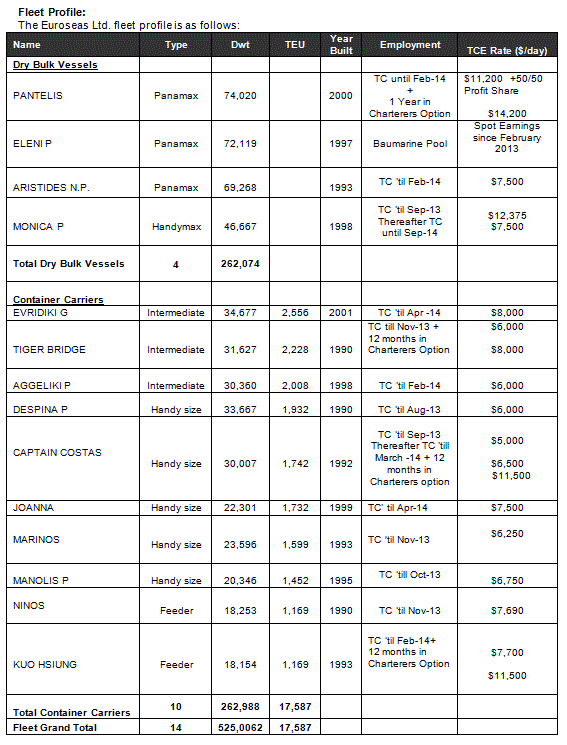
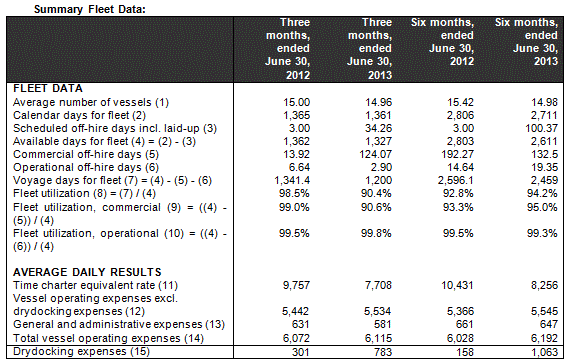
(1) Average number of vessels is the number of vessels that constituted our fleet for the relevant period, as measured by the sum of the number of calendar days each vessel was a part of our fleet during the period divided by the number of calendar days in that period.
(2) Calendar days. We define calendar days as the total number of days in a period during which each vessel in our fleet was in our possession including off-hire days associated with major repairs, drydockings or special or intermediate surveys or days of vessels in lay-up. Calendar days are an indicator of the size of our fleet over a period and affect both the amount of revenues and the amount of expenses that we record during that period.
(3) The scheduled off-hire days including vessels laid-up are days associated with scheduled repairs, drydockings or special or intermediate surveys or days of vessels in lay-up. We use available days to measure the number of days in a period during which vessels were available to generate revenues.
(4) Available days. We define available days as the total number of days in a period during which each vessel in our fleet was in our possession net of scheduled off-hire days including days of vessels laid-up.
(5) Commercial off-hire days. We define commercial off-hire days as days waiting to find employment.
(6) Operational off-hire days. We define operational off-hire days as days associated with unscheduled repairs or other off-hire time related to the operation of the vessels,
(7) Voyage days. We define voyage days as the total number of days in a period during which each vessel in our fleet was in our possession net of commercial and operational off-hire days. We use voyage days to measure the number of days in a period during which vessels actually generate revenues.
(8) Fleet utilization. We calculate fleet utilization by dividing the number of our voyage days during a period by the number of our available days during that period. We use fleet utilization to measure a company's efficiency in finding suitable employment for its vessels and minimizing the amount of days that its vessels are off-hire for reasons such as unscheduled repairs or days waiting to find employment.
(9) Fleet utilization, commercial. We calculate commercial fleet utilization by dividing our available days net of commercial off-hire days during a period by our available days during that period.
(10) Fleet utilization, operational. We calculate operational fleet utilization by dividing our available net of operational off-hire days during a period by our available days during that period.
(11) Time charter equivalent, or TCE, is a measure of the average daily revenue performance of a vessel on a per voyage basis. Our method of calculating TCE is consistent with industry standards and is determined by dividing revenue generated from voyage charters net of voyage expenses by voyage days for the relevant time period. Voyage expenses primarily consist of port, canal and fuel costs that are unique to a particular voyage, which would otherwise be paid by the charterer under a time charter contract. TCE is a standard shipping industry performance measure used primarily to compare period-to-period changes in a shipping company's performance despite changes in the mix of charter types (i.e., spot voyage charters, time charters and bareboat charters) under which the vessels may be employed between the periods.
(12) Daily vessel operating expenses, which includes crew costs, provisions, deck and engine stores, lubricating oil, insurance, maintenance and repairs and management fees are calculated by dividing vessel operating expenses by fleet calendar days for the relevant time period. Drydocking expenses are reported separately.
(13) Daily general and administrative expense is calculated by dividing general and administrative expense by fleet calendar days for the relevant time period.
(14) Total vessel operating expenses, or TVOE, is a measure of our total expenses associated with operating our vessels. TVOE is the sum of vessel operating expenses excluding drydocking expenses and general and administrative expenses. Daily TVOE is calculated by dividing TVOE by fleet calendar days for the relevant time period.
(15) Drydocking expenses, which include expenses during drydockings that would have been capitalized and amortized under the deferral method divided by the fleet calendar days for the relevant period. Drydocking expenses could vary substantially from period to period depending on how many vessels underwent drydocking during the period.
Conference Call and Webcast:
Tomorrow, Tuesday, August 13, 2013 at 10:00 a.m. EDT, the company's management will host a conference call to discuss the results.
Conference Call details:
Participants should dial into the call 10 minutes before the scheduled time using the following numbers: 1 866 819 7111 (from the US), 0800 953 0329 (from the UK) or +44 (0)1452 542 301 (international standard dial in). Please quote "Euroseas".
A recording of the conference call will be available until August 20, 2013 by dialing 1 866 247 4222 (from the US), 0800 953 1533 (from the UK) or +44 (0)1452 550 000 (international standard dial in). Access Code: 6973591#
Audio webcast - Slides Presentation:
There will be a live and then archived audio webcast of the conference call, via the internet through the Euroseas website (www.euroseas.gr). Participants to the live webcast should register on the website approximately 10 minutes prior to the start of the webcast. A slide presentation on the Second Quarter and First Half 2013 results in PDF format will also be available 10 minutes prior to the conference call and webcast accessible on the company's website (www.euroseas.gr) on the webcast page. Participants to the webcast can download the PDF presentation.
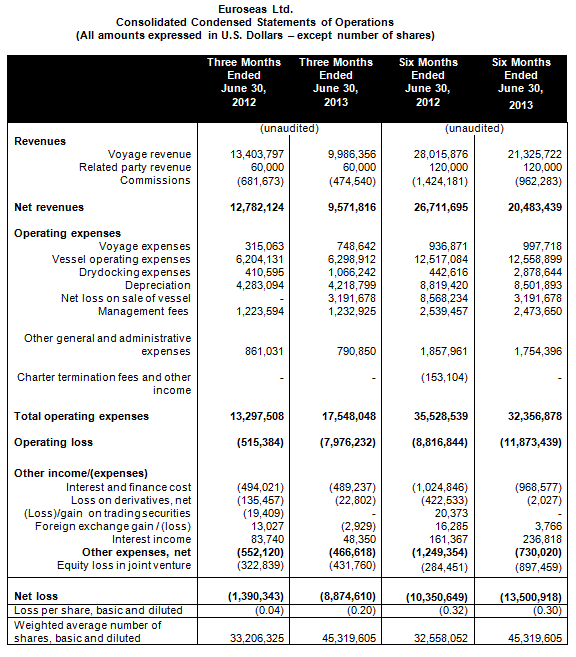
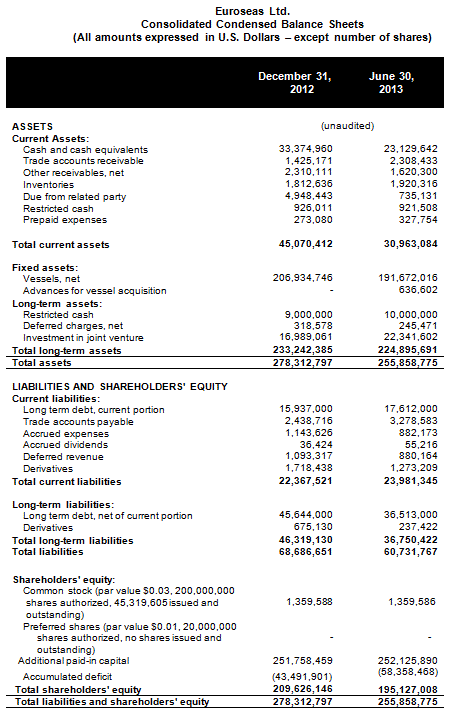
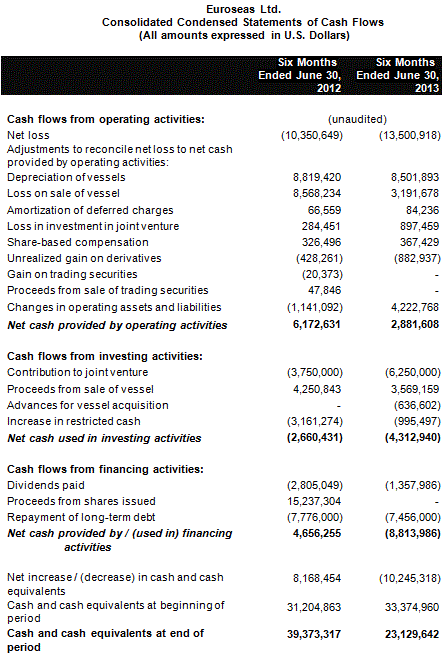
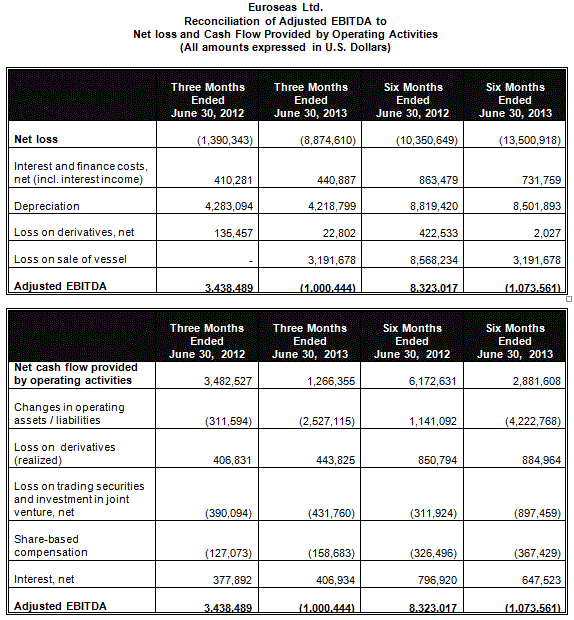
Adjusted EBITDA Reconciliation:
Euroseas Ltd. considers Adjusted EBITDA to represent net loss before interest, income taxes, depreciation, amortization, gain / loss on derivatives, and loss on sale of vessel. Adjusted EBITDA does not represent and should not be considered as an alternative to net income/loss or cash flow from operations, as determined by United States generally accepted accounting principles, or U.S. GAAP, and our calculation of Adjusted EBITDA may not be comparable to that reported by other companies. Adjusted EBITDA is included herein because it is a basis upon which we assess our financial performance and liquidity position and because we believe that it presents useful information to investors regarding a company's ability to service and/or incur indebtedness. The Company's definition of Adjusted EBITDA may not be the same as that used by other companies in the shipping or other industries.
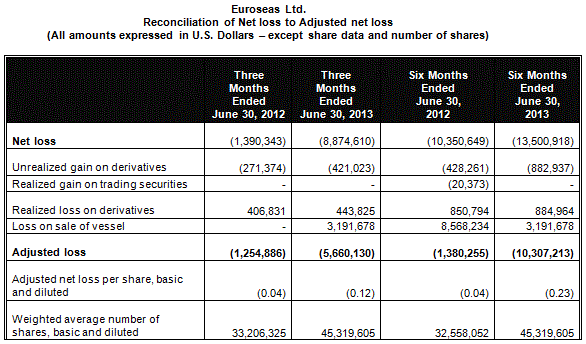
Adjusted Net Loss and Adjusted Net Loss per share Reconciliation:
Euroseas Ltd. considers Adjusted Net Income/(loss) to represent net loss before gain / loss in derivatives, realized gain on trading securities, and loss on sale of vessel. Adjusted Net loss and Adjusted Net loss per share is included herein because we believe it assists our management and investors by increasing the comparability of the Company's fundamental performance from period to period by excluding the potentially disparate effects between periods of gain / loss in derivatives and realized gain on trading securities, which items may significantly affect results of operations between periods.
Adjusted Net loss and Adjusted Net loss per share do not represent and should not be considered as an alternative to net loss or loss per share, as determined by U.S. GAAP, The Company's definition of Adjusted Net loss and Adjusted Net loss per share may not be the same as that used by other companies in the shipping or other industries
About Euroseas Ltd.
Euroseas Ltd. was formed on May 5, 2005 under the laws of the Republic of the Marshall Islands to consolidate the ship owning interests of the Pittas family of Athens, Greece, which has been in the shipping business over the past 136 years. Euroseas trades on the NASDAQ Global Market under the ticker ESEA since January 31, 2007.
Euroseas operates in the dry cargo, drybulk and container shipping markets. Euroseas' operations are managed by Eurobulk Ltd., an ISO 9001:2008 certified affiliated ship management company, which is responsible for the day-to-day commercial and technical management and operations of the vessels. Euroseas employs its vessels on spot and period charters and through pool arrangements.
The Company has a fleet of 14 vessels, including 3 Panamax drybulk carriers and 1 Handymax drybulk carrier, 3 Intermediate containerships, 5 Handysize containerships and 2 Feeder containership vessels. Euroseas' 4 drybulk carriers have a total cargo capacity of 262,074 dwt and its 10 containerships have a cargo capacity of 17,587 teu.
Forward Looking Statement
This press release contains forward-looking statements (as defined in Section 27A of the Securities Act of 1933, as amended, and Section 21E of the Securities Exchange Act of 1934, as amended) concerning future events and the Company's growth strategy and measures to implement such strategy; including expected vessel acquisitions and entering into further time charters. Words such as "expects," "intends," "plans," "believes," "anticipates," "hopes," "estimates," and variations of such words and similar expressions are intended to identify forward-looking statements. Although the Company believes that the expectations reflected in such forward-looking statements are reasonable, no assurance can be given that such expectations will prove to have been correct. These statements involve known and unknown risks and are based upon a number of assumptions and estimates that are inherently subject to significant uncertainties and contingencies, many of which are beyond the control of the Company. Actual results may differ materially from those expressed or implied by such forward-looking statements. Factors that could cause actual results to differ materially include, but are not limited to changes in the demand for dry bulk vessels and container ships, competitive factors in the market in which the Company operates; risks associated with operations outside the United States; and other factors listed from time to time in the Company's filings with the Securities and Exchange Commission. The Company expressly disclaims any obligations or undertaking to release publicly any updates or revisions to any forward-looking statements contained herein to reflect any change in the Company's expectations with respect thereto or any change in events, conditions or circumstances on which any statement is based.
Visit our website www.euroseas.gr
Company Contact
Tasos Aslidis
Chief Financial Officer
Euroseas Ltd.
11 Canterbury Lane,
Watchung, NJ 07069
Tel. (908) 301-9091
E-mail: aha@euroseas.gr
Investor Relations / Financial Media
Nicolas Bornozis
President
Capital Link, Inc.
230 Park Avenue, Suite 1536
New York, NY 10169
Tel. (212) 661-7566
E-mail: euroseas@capitallink.com
